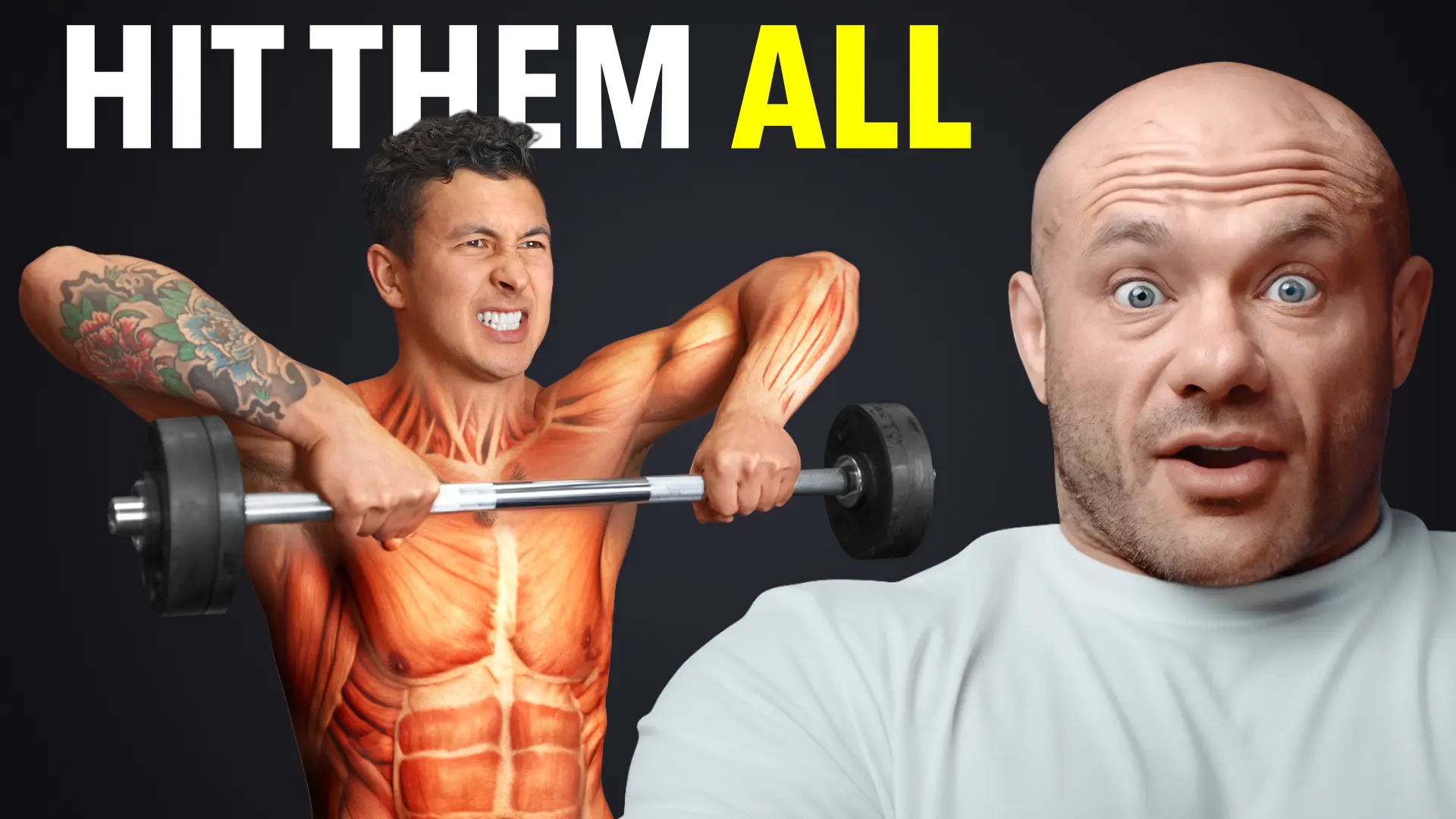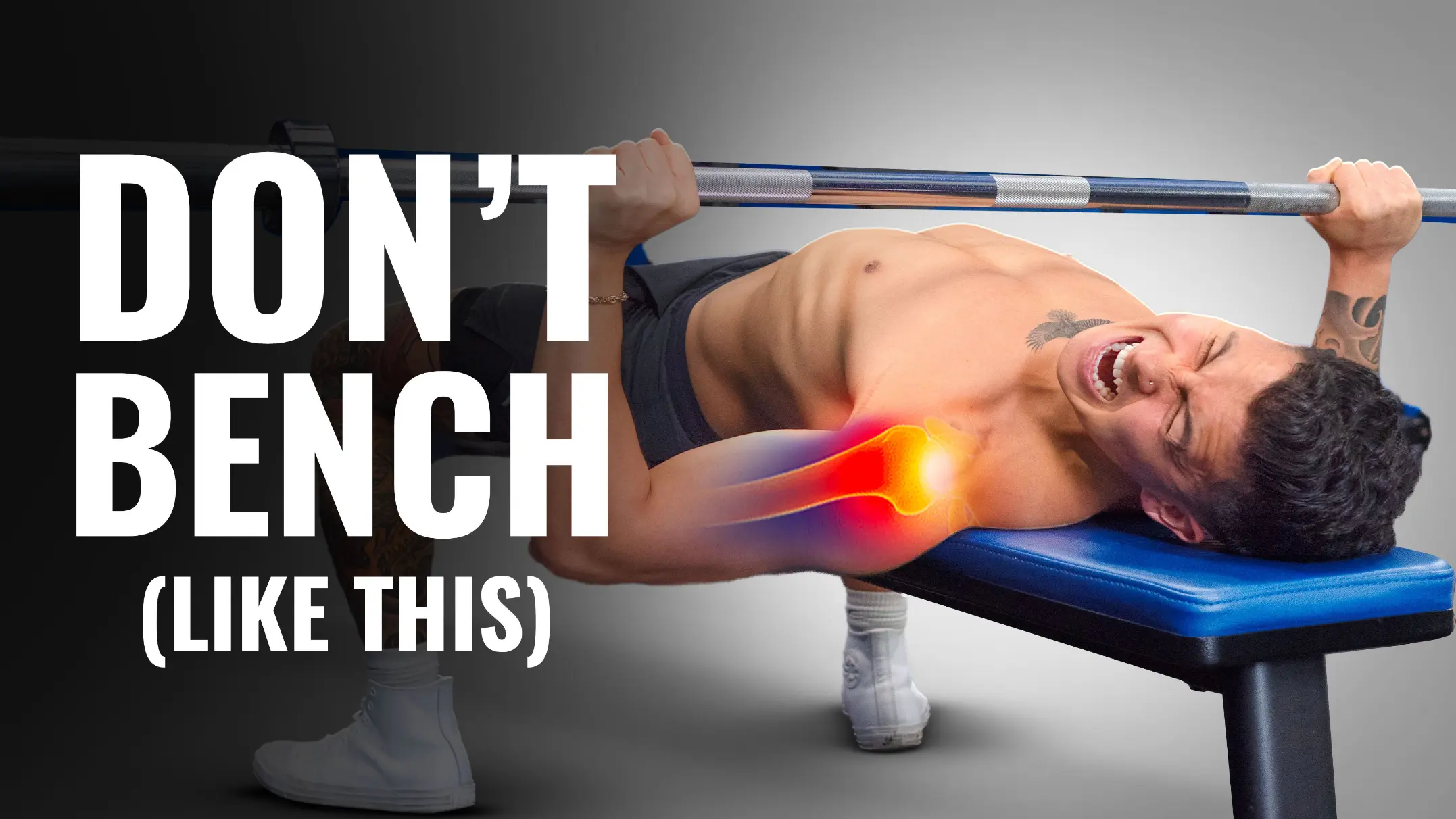
How To Unf*ck Your Barbell Bench Press Form (Fix 5 Mistakes)
Got hurt from the barbell bench press? Or feel it more in your shoulders and arms than your chest? Fix these 5 mistakes.
Do you ever feel pinching or pain in your shoulder when you bench?
Or maybe you end up feeling it more in your shoulders and arms instead of your chest?
Or maybe every time you start going heavy you end up hurting yourself.
This isn’t because the barbell bench press is a bad exercise, it’s just that most people do it wrong.
There are 5 mistakes almost everyone makes on the barbell bench press.
Fix these, and I guarantee your shoulders will thank you, and you’ll start to actually feel your chest activating like never before.
#1: Elbows/Bar Path
The first mistake has to do with your elbow angle.
Raise your elbows to shoulder height and then try to bring them back as far as you can as if you were benching.
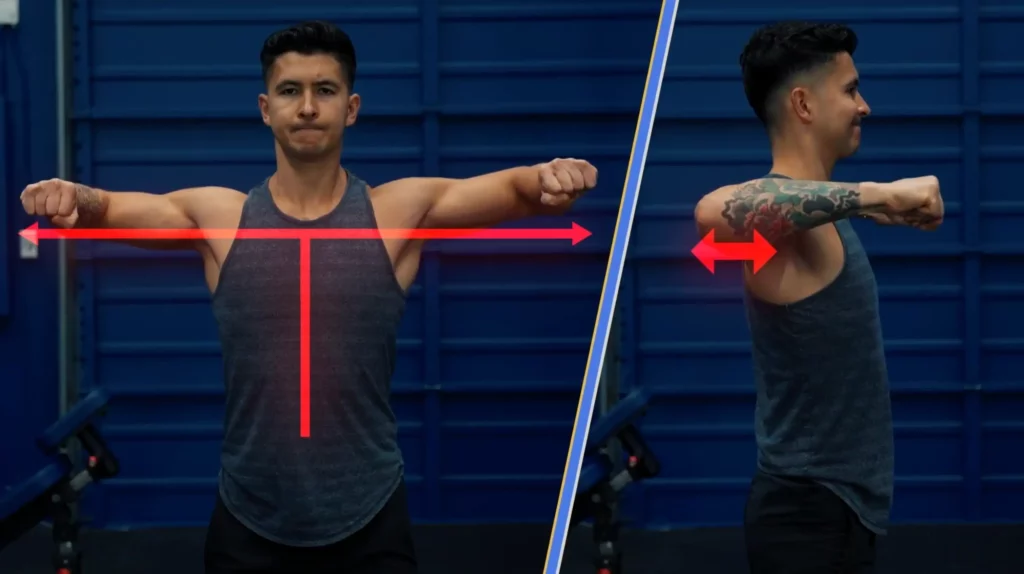
Then, do the same thing again but this time with your elbows angled in an arrow shape.
Notice how much further back you can get.
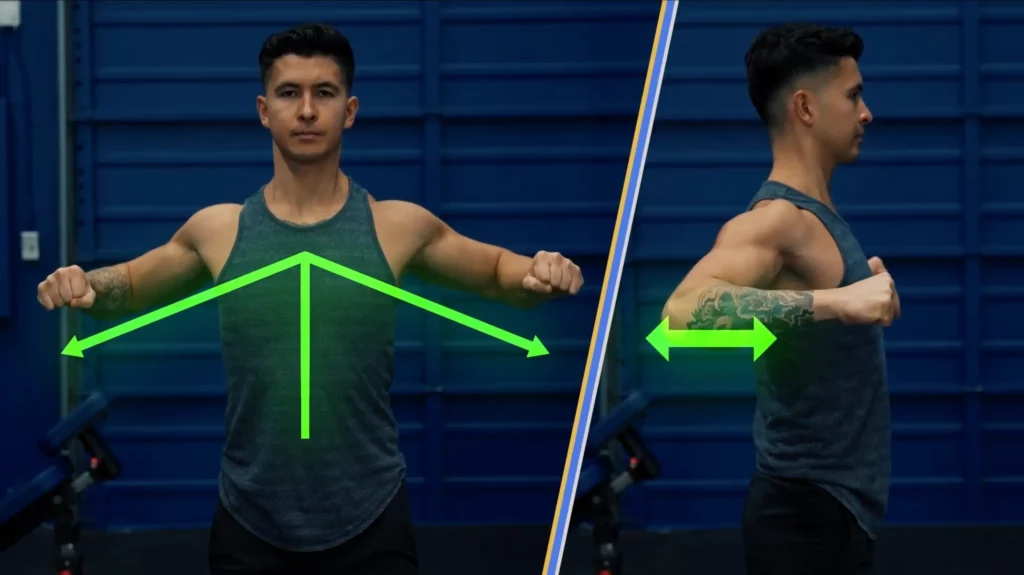
So when you’re doing the barbell bench press, if you use too wide of an elbow angle, you’re going to have a very hard time bringing the bar all the way down to your chest and doing so can create a lot of strain on the shoulders.
On the other hand, a tucked elbow angle will help you:
- Get deeper and
- Better activate your chest since it usually aligns with the direction that most people's chest fibers run
Once you get too wide, the tension shifts from the chest towards other muscles in the shoulder.
However, the perfect elbow angle on the barbell bench press will vary for everyone. Some of you might do better with around 60 degrees whereas others will feel better a bit more flared out.
But rather than whipping out your protractor the next time you perform the barbell bench press, just focus on your bar path.
Finding The "Right" Elbow Angle On The Barbell Bench Press
If you use too wide of an elbow angle, the bar would travel pretty much straight up and down right over your upper chest.
But with your elbows tucked, you’re forced to move the bar slightly forward on the way down and slightly backward on the way up.
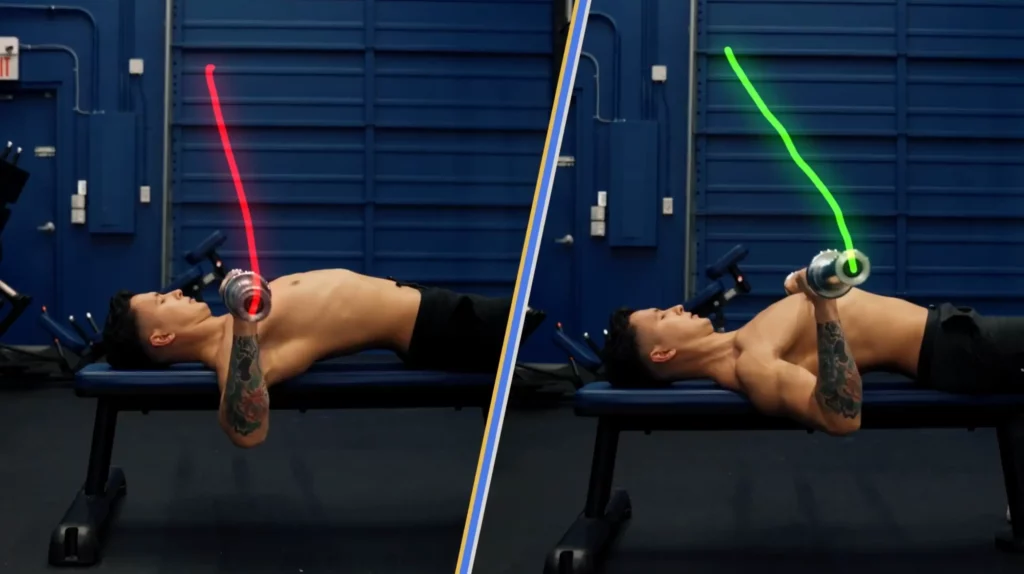
So if you simply focus on touching your lower chest or nipples with the bar when performing the barbell bench press, then your elbows should naturally end up in the right place.
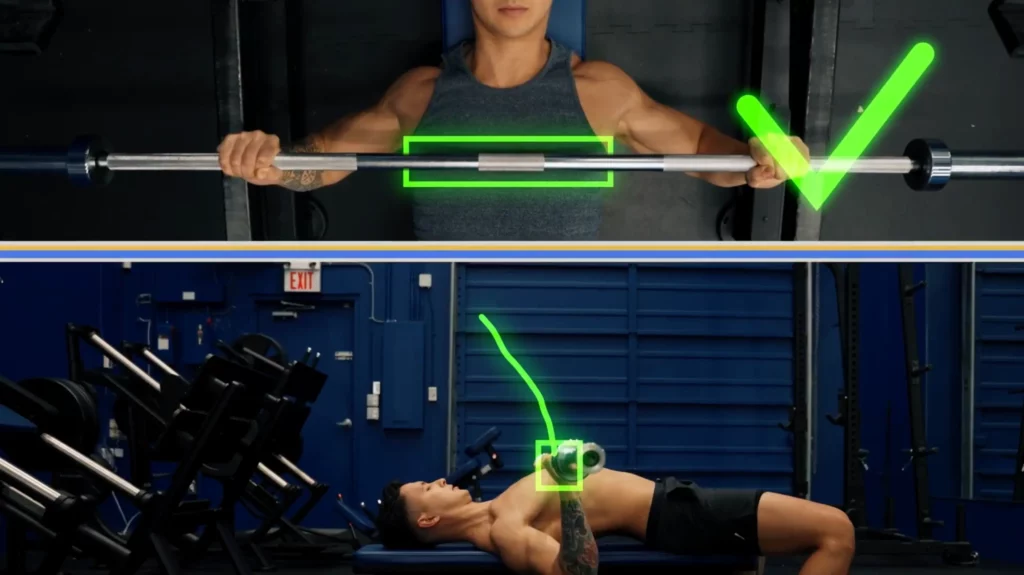
What If You Bench Press On The Smith Machine?
However, maybe some of you bench on the Smith machine and are wondering how exactly this applies to that.
Well, generally, there are 2 types of Smith machines:
- Angled Smith machines: Face the same direction that the Smith machine path is angled so that the bar moves down and slightly forward on the way down. Then, simply position yourself on the bench such that at the bottom position, the bar touches the level of your lower chest right around your sternum.
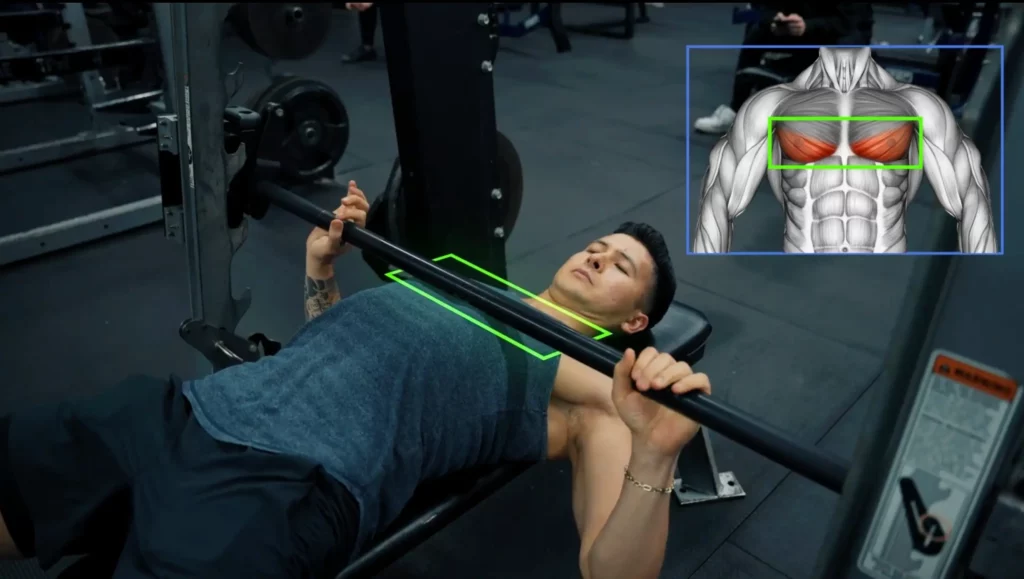
- Straight up and down Smith machines: You won't be able to get an angled bar path. In this case, I'd recommend just positioning yourself such that the bar sits right around the level of your mid to lower chest. As long as your elbows aren't completely flared out at this bottom position, it should be fine.
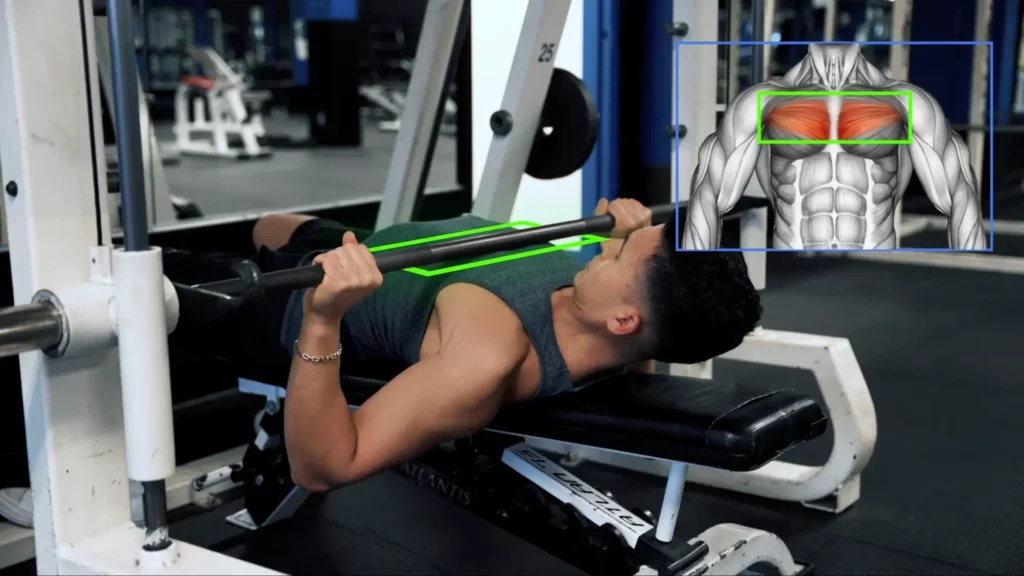
#2: Grip Width
Now in order to properly do the previous tip, you need to fix your grip on the barbell bench press.
Note: all the following tips are applicable for the Smith machine bench press, too, if that's your preferred benching exercise. I'll just refer to the barbell bench press for the rest of this article for brevity's sake.
Most people just use the same grip as their friend, or they’ll follow the markers on the bar.
But the right grip depends on your body.
For example, let’s take a look at quite an interesting 2022 study.
They had 27 trained subjects perform the bench press and analyzed the activation of their chest, shoulders, and triceps.
Now even though all the subjects used the exact same grip width, some of them experienced the highest activation in their chest, some saw the highest activation in their shoulders, and others saw the highest activation in their triceps.
Suggesting that a grip that works well for someone else may not work the same way for you.
How To Find The Right Grip For Your Body
But finding the right grip on the barbell bench press for your body is actually quite simple.
Next time you’re on the bench, rest the bar on your lower chest, the target touch point we covered back in the previous step.
If at this point your forearms are angled in, your grip is probably too narrow and will lead to more triceps involvement.
Whereas if your forearms are angled out, it’s probably too wide.
Although this grip is often used by powerlifters since it can help boost your strength, in my experience, it often leads to less chest involvement, and some research shows it may lead to a higher risk of shoulder injury.
Instead, to get more chest with less stress on your joints, at this bottom position your wrist, forearms, and elbow should ideally be straight up and down stacked directly under the bar.
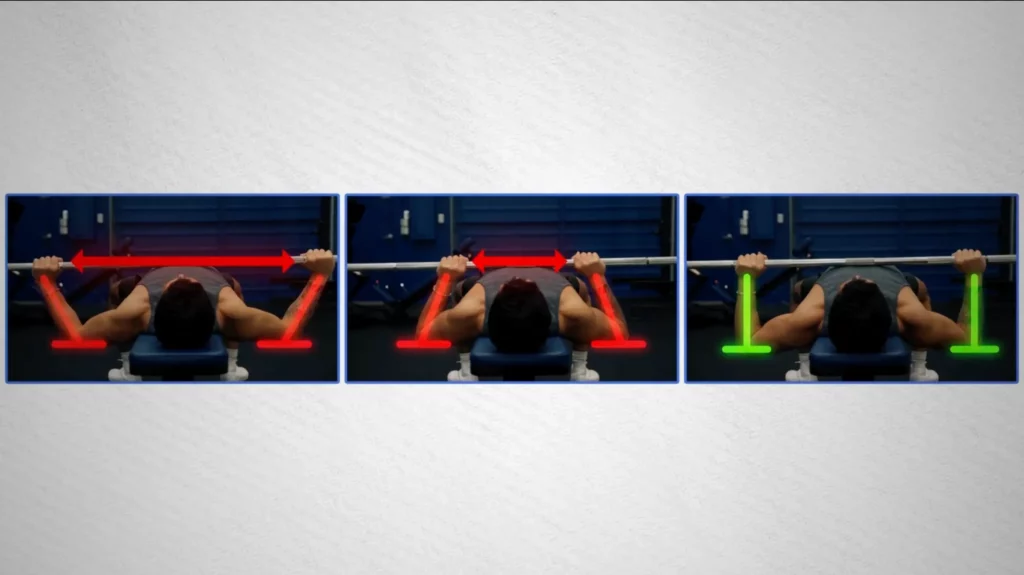
However far away your hands need to be to accomplish that is your ideal grip width for the barbell bench press.
#3: Letting Your Shoulders Take Over
So you’re using the right grip, and you’re not flaring your elbows out too much on the way down on the barbell bench press.
But there’s a common mistake you want to avoid on the way up.
You see, if your shoulders are relatively stronger compared to your chest, you’ll tend to let your chest cave in, and your shoulders roll forward and take over.
This is usually why people feel their front delts get sore after benching instead of the chest.
(Learn how to develop all 3 delts evenly in this article.)
Now it’s unclear as to how well muscle activation predicts growth, but I did want to see if my EMG machine would tell the same story.
So on both myself and my friend Max, I measured the activation of the chest and shoulders when using the improper form compared to the correct form I’m about to show you, using the same relative load.
On both of us, especially Max, the correct form led to more chest activation and less front delt activation.
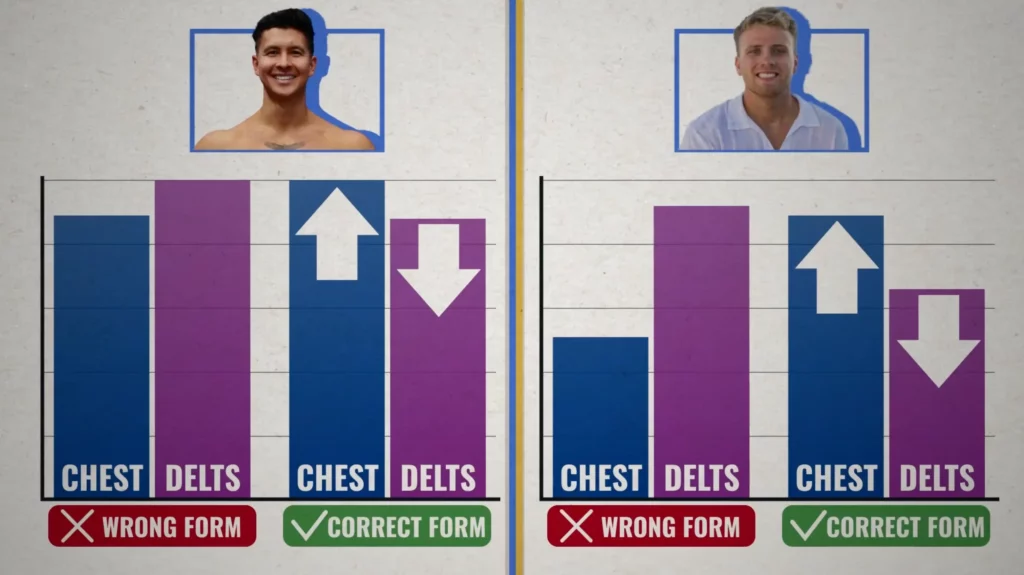
Correct Form On The Bench Press
Now as for how to execute the correct form on the barbell bench press, start by creating a “proud chest” by sticking your chest up towards the ceiling.
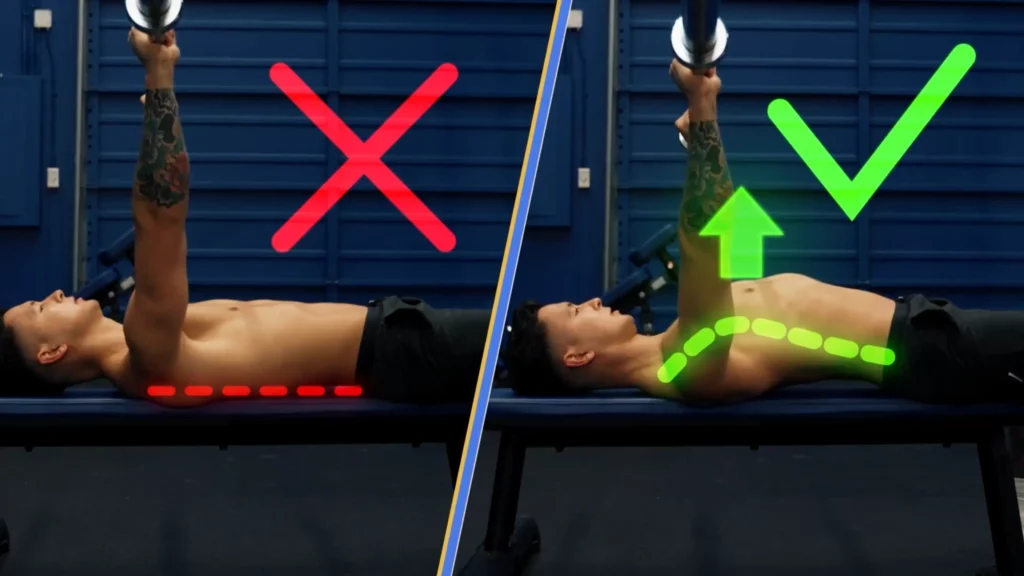
Then, use your back muscles to pull the bar down to your chest as if you were doing a row, squeezing your shoulder blades together and keeping your chest up and proud.
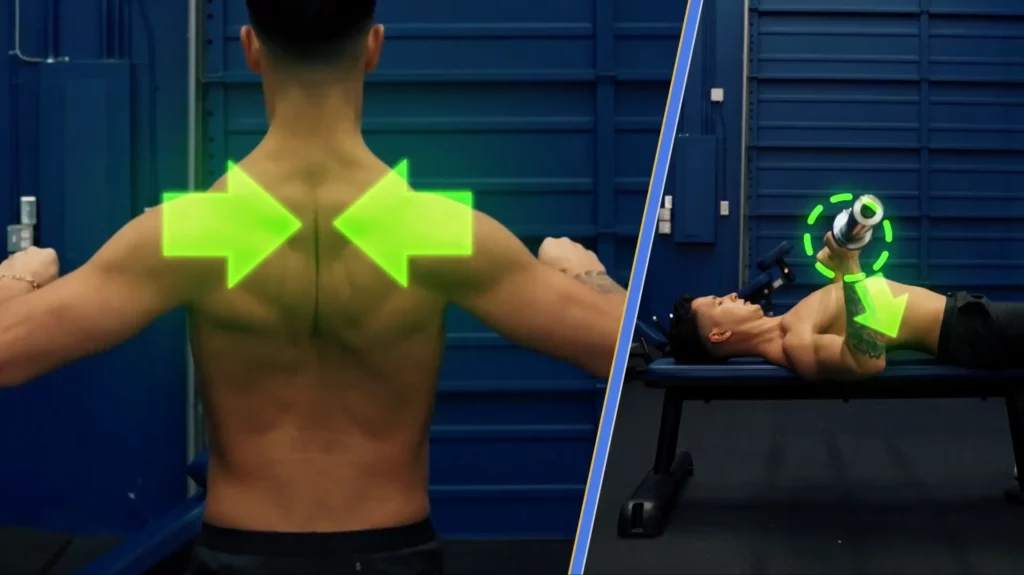
Lightly touch the bar with your chest, and then on the way up, don’t just think about “pushing the weight up”.
The main function of the chest is horizontal adduction, or bringing your arms together.
So to prevent your shoulders from taking over on the barbell bench press, keep your chest up and think about squeezing your biceps into the sides of your chest as if you were trying to touch your biceps together.
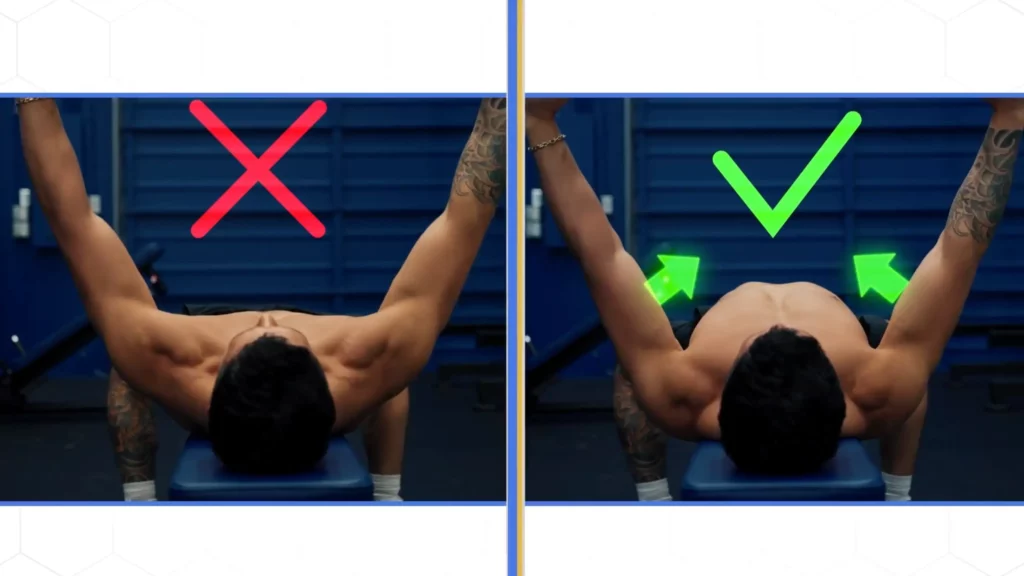
It’s less of a “punching” motion and more of a “squeezing” motion.
You may have to lighten the weight to do this properly, but it’ll ensure your chest is doing the work rather than your shoulders.
#4: Stability
The next fix has to do with your setup.
Most people, when they perform the barbell bench press, their feet are tapping all over the place, and their body is very “loose”.
But notice how powerlifters often take their time setting up before their big squat or deadlift.
You may not be able to see it, but they’re tensing their back, core, and several other muscles to make their body as stable as possible when they lift.
This not only gives them more strength and power but also reduces the risk of potential injury or compensation in their form.
Think about how easy it is to smash an empty can compared to when it’s unopened and full of pressure.
That’s the stability and rigidness you want to create every time you do the barbell bench press.
How To Create Stability For Your Barbell Bench Press
Here’s how to do it.
Start with the lower body.
Use a wide stance with your feet planted under your knees.
Push your knees out and lightly drive your feet forward to activate your quads and glutes.
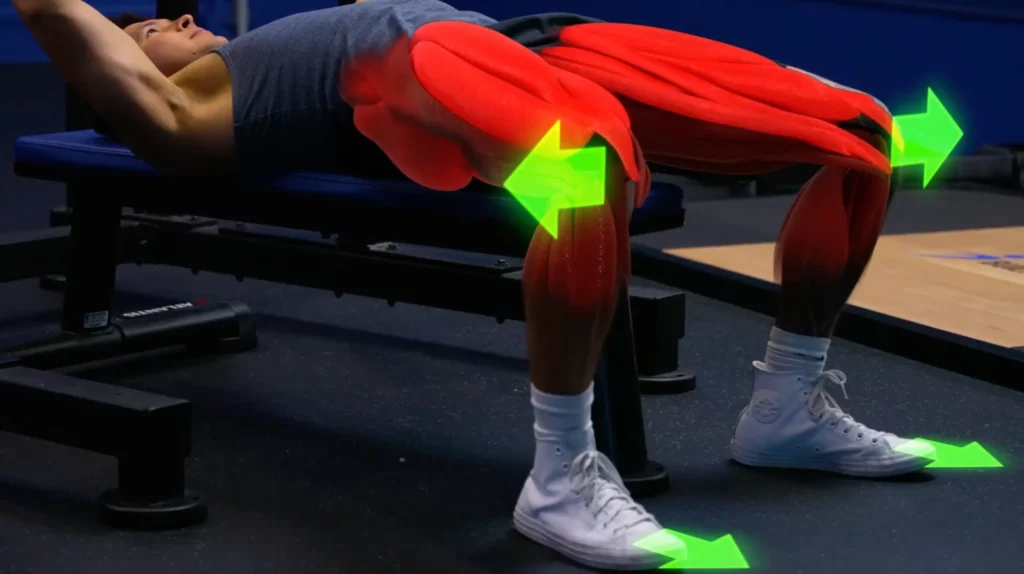
For the upper body, activate your lats by bringing your armpits down towards your hips.
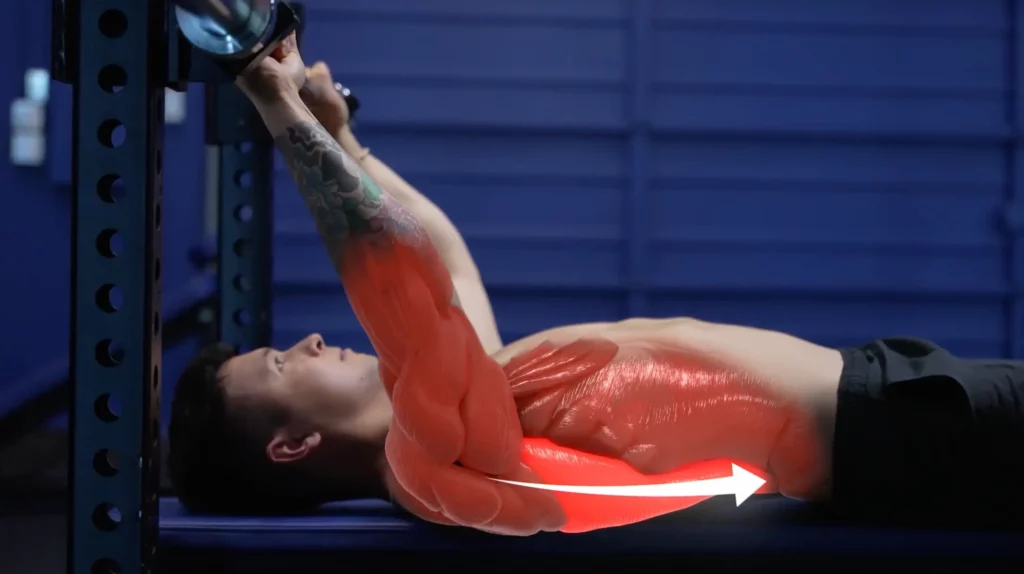
Then, after you unrack it, squeeze the bar hard and think about twisting your hands outwards as if you were trying to bend the bar into a U shape towards your feet.
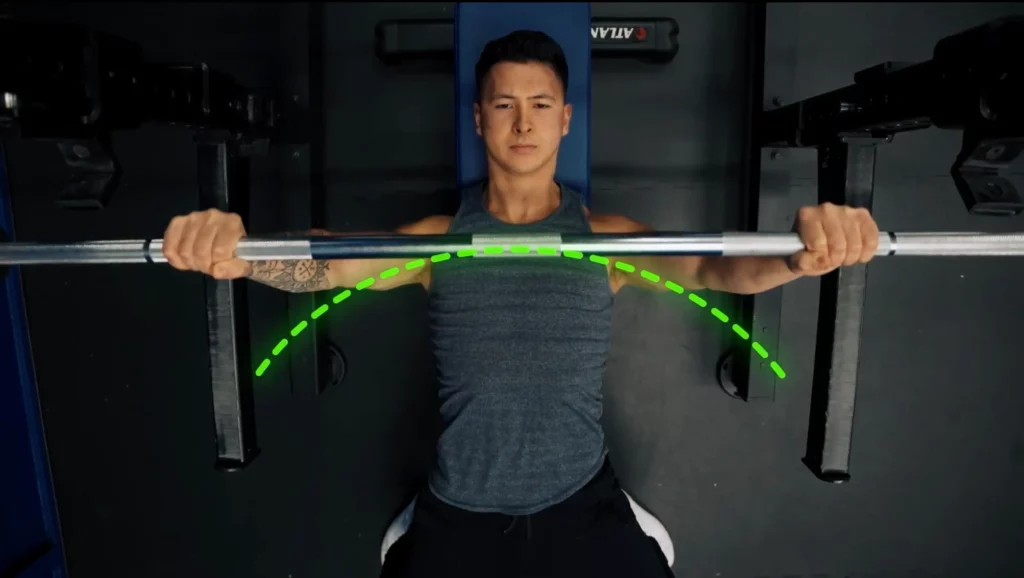
Take a deep breath into your stomach, and brace your core as if you coughed really hard.
By creating this whole-body tension before you press, you’ll be able to transfer energy just like a bow.
#5: Don't Be Stubborn
So the last fix may not be what you’re expecting.
I want to highlight a recent 2023 meta-analysis which is basically a massive study of studies.
The researchers tried to see if doing free weights like the barbell bench press led to more growth compared to using machines like the Smith machine.
They found no significant differences.
Another 2023 study found the same thing.
So if you apply all the fixes I mentioned in this article yet you’re still having trouble with the bench press, then your body honestly just may not be well suited to bench press.
But unless you’re a competitive powerlifter, you shouldn’t feel like you have to bench press.
What To Do If Bench Pressing Isn't For You
You can still make just as good of gains with chest machines or even dumbbells where your joints can move a lot more freely (e.g., compared to the barbell bench press).
Also, consider playing with the range of motion.
If you draw a line between the two handles when using dumbbells, you’d be surprised with how deep you actually have to go in order to mimic touching your chest during the bench press.
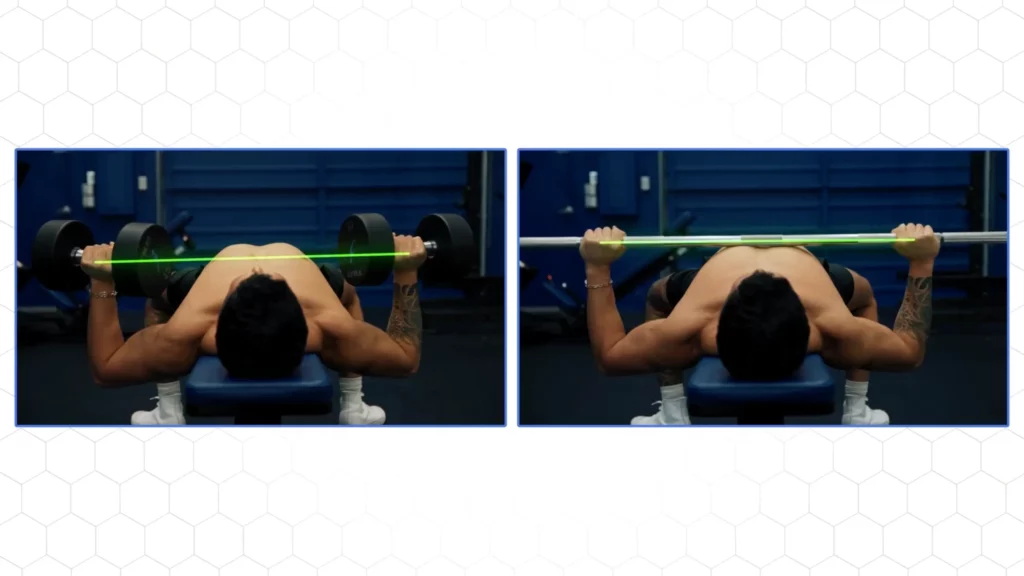
FYI, curious to know whether barbells or dumbbells lead to better growth? Find the answer here.
So if going all the way down when benching if that’s what aggravates your shoulder or you just don’t have the mobility for that yet, stop an inch or two short.
Just don’t be stubborn. If your body is telling you it doesn’t like the way something feels, then listen to it.
TL;DR
- Focus on touching your lower chest or nipples with the bar on the barbell bench press; this is the perfect elbow angle for you. Note: this varies on the Smith machine.
- To determine the right grip, at the bottom position, your wrist, forearms, and elbow should ideally be stacked directly under the bar.
- Keep your chest up and think about squeezing your biceps into the sides of your chest. This prevents your shoulders from taking over.
- Create whole-body tension before performing the bench press. You’ll need leg drive, packed lats, and a braced core to do so.
- Finally, don’t be stubborn. You don’t have to bench press if it’s not comfortable for you. Play around with dumbbells/chest machines or range of motion.
Regardless of what exercise you choose to do, you always need to make sure you’re using the proper form.
Poor technique is the single biggest reason why many people end up hurting themselves in the gym or just don’t see very good results from their workouts.
For a step-by-step program that not only builds your workout for you but teaches you in-depth how to perform each and every exercise in your program, just take our quiz below to find the best plan for you and your body. It's worked for thousands of others, and it will work for you.
Click the button below to take my analysis quiz to discover the best program for you:
↓
Highly recommend giving this article a read next to fix your deadlifts or this a read next to fix your squat.
Thanks for sticking till the end, and I'll see you next time!




